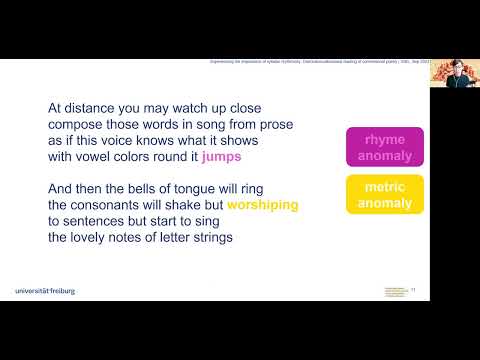 Speaker: Judith Beck @Judy
Speaker: Judith Beck @Judy
 Affiliation: Department of Psychology, Center for Cognitive Science, University of Freiburg (GER)
Affiliation: Department of Psychology, Center for Cognitive Science, University of Freiburg (GER)
Title: Experiencing the importance of syllabic rhythmicity: Oral/subvocalizational reading of conventional poetry
Abstract (long version below): In this symposium, results from research using different methods such as pupillometry, eye-tracking, EEG, or applied informatics such as neural network analysis are presented with respect to empirical literary sciences to discuss how phenomena related to the genuine poetic rhythm and associated cognitive effects can be explored. The focus is twofold: A) Advantages and disadvantages of the respective method and its combinability with other methods are to be thematized. B) Based on the results from the respective approaches presented, the extent to which they provide information about cognitive processing, respectively, experiencing of poetic rhythm will be debated.

 Long abstract
Long abstract
In conventional poetry, a specific rhythm is derived from the composed sequence of syllables and their respective phonemic quality. How readers realize this rhythm, e.g. by inferring a beat from the “rhythmic gestalt” and projecting a meter, is a phenomenon that has not yet been sufficiently explored. In a first experiment [1], participants’ (n = 38) eye-movements were tracked to investigate rhythmic effects in silent reading of poetry. Stimuli were presented as original or manipulated (metrical & rhyme anomalies or both) and in two layouts (prose/poetry). Results reveal readers’ sensitivity towards rhythmic-gestalt-anomalies: In poem layout, metrical anomalies elicited disruptions and re-reading of local context. In prose layout, a stronger effect of rhyme anomalies and indicators for systematic re-reading of pre-rhymes were found. The presence or absence of manipulation had a general effect on reading. Additionaly, the effects of syllable number showed a high degree of subvocalization. In a second experiment [2], audio recordings of subjects’ (n = 13) reading poetry aloud were analyzed using PRAAT and a mixed effects regression model approach. Of main interest was how top-down and bottom-up processes would interact, i.e. applying a leading metrical grid while processing syllabic material. Poems were manipulated by replacing regular syllables at random positions with the syllable “tack”. Syllable onset interval (SOI) and mean intensity were used as operationalisation of how strongly a syllable was stressed. Articulation duration (SOIs) for strong syllables was on average longer than for weak ones, however, the effect disappeared for “tacks”. Syllable intensities captured metrical stress of “tacks”, but only for musically active participants. Additional normalized pairwise variability index (nPVI)-results indicated that for SOIs, lines were read less altering. This effect was proportional to the number of tacks per line. Overall, our findings reveal readers’ rhythmic and spatio-temporal experiences are shaped by poems’ syllabic composition.
References
1.Beck, J., & Konieczny, L. (2021). Rhythmic subvocalization: An eye-tracking study on silent poetry reading. Journal of Eye Movement Research, 13(3). https://doi.org/10.16910/jemr.13.3.5
2.Beck, J., & Konieczny, L. (2023). What a difference a syllable makes—Rhythmic reading of poetry. Frontiers in Psychology, 14, 1043651. https://doi.org/10.3389/fpsyg.2023.1043651

